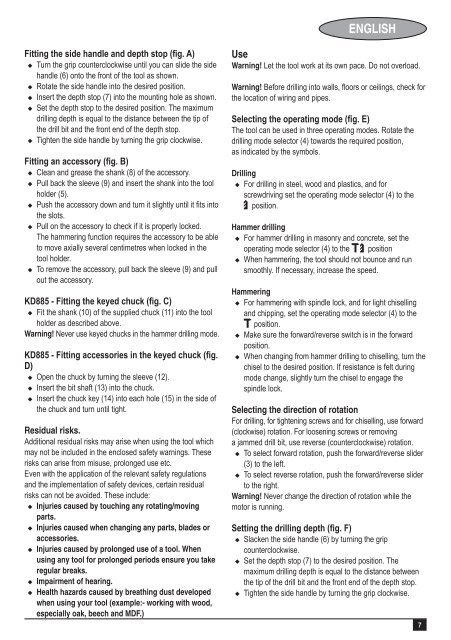BlackandDecker Martello Ruotante- Kd885 - Type 1 - Instruction Manual (Europeo)
BlackandDecker Martello Ruotante- Kd885 - Type 1 - Instruction Manual (Europeo)
BlackandDecker Martello Ruotante- Kd885 - Type 1 - Instruction Manual (Europeo)
You also want an ePaper? Increase the reach of your titles
YUMPU automatically turns print PDFs into web optimized ePapers that Google loves.
ENGLISH<br />
Fitting the side handle and depth stop (fig. A)<br />
u Turn the grip counterclockwise until you can slide the side<br />
handle (6) onto the front of the tool as shown.<br />
u Rotate the side handle into the desired position.<br />
u Insert the depth stop (7) into the mounting hole as shown.<br />
u Set the depth stop to the desired position. The maximum<br />
drilling depth is equal to the distance between the tip of<br />
the drill bit and the front end of the depth stop.<br />
u Tighten the side handle by turning the grip clockwise.<br />
Fitting an accessory (fig. B)<br />
u Clean and grease the shank (8) of the accessory.<br />
u Pull back the sleeve (9) and insert the shank into the tool<br />
holder (5).<br />
u Push the accessory down and turn it slightly until it fits into<br />
the slots.<br />
u Pull on the accessory to check if it is properly locked.<br />
The hammering function requires the accessory to be able<br />
to move axially several centimetres when locked in the<br />
tool holder.<br />
u To remove the accessory, pull back the sleeve (9) and pull<br />
out the accessory.<br />
KD885 - Fitting the keyed chuck (fig. C)<br />
u Fit the shank (10) of the supplied chuck (11) into the tool<br />
holder as described above.<br />
Warning! Never use keyed chucks in the hammer drilling mode.<br />
KD885 - Fitting accessories in the keyed chuck (fig.<br />
D)<br />
u Open the chuck by turning the sleeve (12).<br />
u Insert the bit shaft (13) into the chuck.<br />
u Insert the chuck key (14) into each hole (15) in the side of<br />
the chuck and turn until tight.<br />
Residual risks.<br />
Additional residual risks may arise when using the tool which<br />
may not be included in the enclosed safety warnings. These<br />
risks can arise from misuse, prolonged use etc.<br />
Even with the application of the relevant safety regulations<br />
and the implementation of safety devices, certain residual<br />
risks can not be avoided. These include:<br />
u Injuries caused by touching any rotating/moving<br />
parts.<br />
u Injuries caused when changing any parts, blades or<br />
accessories.<br />
u Injuries caused by prolonged use of a tool. When<br />
using any tool for prolonged periods ensure you take<br />
regular breaks.<br />
u Impairment of hearing.<br />
u Health hazards caused by breathing dust developed<br />
when using your tool (example:- working with wood,<br />
especially oak, beech and MDF.)<br />
Use<br />
Warning! Let the tool work at its own pace. Do not overload.<br />
Warning! Before drilling into walls, floors or ceilings, check for<br />
the location of wiring and pipes.<br />
Selecting the operating mode (fig. E)<br />
The tool can be used in three operating modes. Rotate the<br />
drilling mode selector (4) towards the required position,<br />
as indicated by the symbols.<br />
Drilling<br />
u For drilling in steel, wood and plastics, and for<br />
screwdriving set the operating mode selector (4) to the<br />
r position.<br />
Hammer drilling<br />
u For hammer drilling in masonry and concrete, set the<br />
operating mode selector (4) to the<br />
s position<br />
u When hammering, the tool should not bounce and run<br />
smoothly. If necessary, increase the speed.<br />
Hammering<br />
u For hammering with spindle lock, and for light chiselling<br />
and chipping, set the operating mode selector (4) to the<br />
q position.<br />
u Make sure the forward/reverse switch is in the forward<br />
position.<br />
u When changing from hammer drilling to chiselling, turn the<br />
chisel to the desired position. If resistance is felt during<br />
mode change, slightly turn the chisel to engage the<br />
spindle lock.<br />
Selecting the direction of rotation<br />
For drilling, for tightening screws and for chiselling, use forward<br />
(clockwise) rotation. For loosening screws or removing<br />
a jammed drill bit, use reverse (counterclockwise) rotation.<br />
u To select forward rotation, push the forward/reverse slider<br />
(3) to the left.<br />
u To select reverse rotation, push the forward/reverse slider<br />
to the right.<br />
Warning! Never change the direction of rotation while the<br />
motor is running.<br />
Setting the drilling depth (fig. F)<br />
u Slacken the side handle (6) by turning the grip<br />
counterclockwise.<br />
u Set the depth stop (7) to the desired position. The<br />
maximum drilling depth is equal to the distance between<br />
the tip of the drill bit and the front end of the depth stop.<br />
u Tighten the side handle by turning the grip clockwise.<br />
7
















